Film of the Week: A Pigeon Sat on a Branch Reflecting on Existence
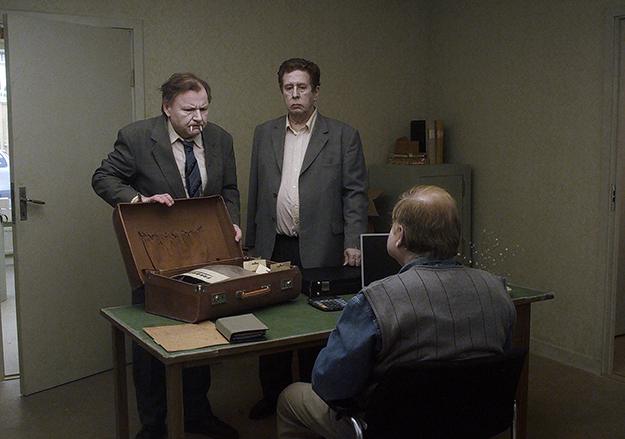 All images courtesy Studio 24
All images courtesy Studio 24
It’s a common tactic, when defending filmmakers who stick doggedly to the same thematic or stylistic ground, to invoke Samuel Beckett. Yes, some artists repeat themselves; Beckett did it all the time, and no one ever saw that as a flaw. I’ve certainly made that case in the past with regard to Swedish filmmaker Roy Andersson, but in some ways Andersson is more Beckettian than Beckett. In reality, the Irish master practiced far more variation than he’s often given credit for: to put it bluntly, a character in one of his plays may be embedded in soil up to the neck, or reduced to a mouth suspended in darkness, or dissolved down to a pure disembodied effect of language.
That’s a lot more variation than we’ve seen from Andersson in the last 25 years. His new film, Venice Golden Lion winner A Pigeon Sat on a Branch Reflecting on Existence, substantially revisits the themes, style, and look of his last feature, You, The Living (07), which was itself a consolidation of his revelatory Songs From the Second Floor (00). That film in turn had expanded the possibilities discovered in Andersson’s 1991 short World of Glory and a whole series of comically black vignettes that earned him a reputation as the most eccentric and consistent auteur working in commercials. (In fact, Songs marked a radical break from the more conventional tenor of Andersson’s first two features, although his 1970 debut A Swedish Love Story is a tender piece of glowing pastoral, well worth tracking down).
It’s perhaps stating the obvious that Andersson is the most Beckettian director working today (although Béla Tarr arguably outdid him in The Turin Horse). He’s Beckettian in his stark, obsessive repetition; in the creation of skeletal fictions played out in spaces that are more of the imagination than of the real world that they ostensibly mimic in trompe l’oeil style; in the sense of human activity and motivation being boiled down to a handful of automatized tics; and in the way that his characters “can’t go on”… but go on anyway. Each of the films in the trilogy inaugurated by Songs seems like a despairing end chapter in an apocalyptic human comedy, a dreadful and decisive full stop (Songs actually ends with a Day of Judgment scenario, as the dead rise up in their masses) and yet there’s always more to be said, always another grim laugh to be squeezed out of the bleak farce that Andersson sees in the human condition.
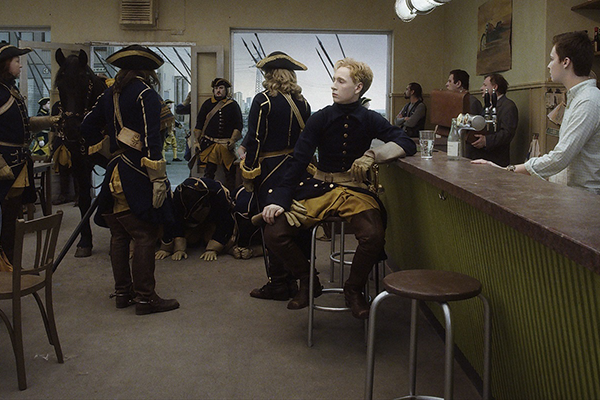
And he does indeed squeeze out the jokes, no matter how dark. Andersson is more adept at walking the thin line between comedy and despair, lugubriousness and mirth, than anyone except Aki Kaurismäki. Mind you, Kaurismäki, old softie that he is, has found it ever harder to conceal his tenderness for people and their quirks—whereas Andersson, though indisputably a humanist, clearly finds us all a lot harder to love.
Here’s an example of how icy Andersson’s humor can be: in a section near the end of Pigeon, prefaced by the title “Homo Sapiens,” a woman in a science lab chats idly away on the phone, occasionally uttering the phrase that is a mantra throughout the film: “I’m happy to hear you’re doing fine.” This may be a meaningless social nicety, or she may indeed be taking pleasure in a friend’s good fortune (although some social commentators have argued that a capacity to genuinely relish others’ success is something we’re really not hard-wired for).
Either way, the humanity the woman apparently shows here is countered by her ability to entirely ignore what’s happening at screen left: a captive monkey, spread-eagled in some monstrous restraining device, electrodes wired to its skull, contorting its face in a rictus of teeth-bared agony as electric charges are administered. Although the horror is intensely distanced (the tableau composition of the fixed shot, the glum little waltz that plays almost subliminally throughout), the distancing itself makes the scene all the more horrible, and all the more horribly comic, to an almost unbearable degree. What’s unbearable is the very fact that we can recognize this scene as a joke, as black comedy, rather than as pure horror. That we can watch it at all says something fairly damning about us—there’s something to muse on when you’re downloading The Human Centipede 3.
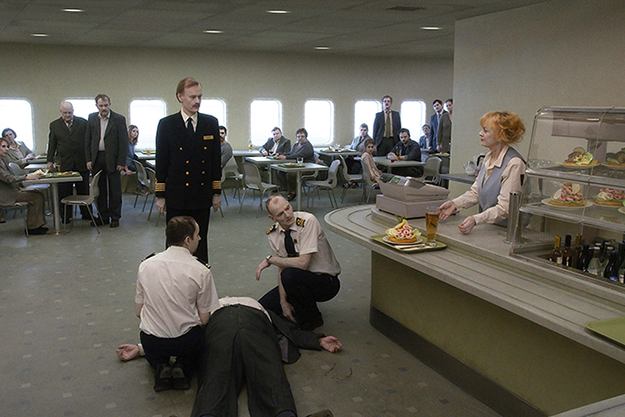
Andersson’s fastidious mise en scène—his huge, elaborate sets are mostly constructed on the sound stages of his own Studio 24 in Stockholm—encourage that distanciation, suspending his vignettes of the human condition like dead matter in preserving jelly: the color scheme of everything, whether clothes, faces, or décor, is glaucous, subaquatic, necrotized (in a Sight & Sound review of Songs, Michael Bracewell memorably referred to “the colors of cold veal, sour milk and sweating mildew”). Andersson’s people, played by actors recruited in the street, are usually—although not always—grotesque and abject, whether obese and ungainly or emaciated and decrepit. This flesh-and-blood cartoonery is Fellini-esque in a familiar sense, and many of his players resemble Nordic equivalents of Duane Hanson sculptures brought to life, but the model Andersson prefers to invoke in interviews is George Grosz and the other artists of the German Neue Sachlichkeit movement.
Some of Andersson’s people still have a semblance of lively energy about them, as if blood still flows in their veins, and there are arguably more of these characters in Pigeon than in the two previous episodes. Most, however, look as if they’re on the verge of death (indeed, some are and expire to comically grim effect) or carry themselves as if already dead. The opening shot of Pigeon shows visitors at a singularly shoddy museum in which the titular pigeon is on display, stuffed in a vitrine; a dinosaur skeleton looms from the next hall; who’s to say that these preserved beasts are any less alive than the humans who glumly observe them?
Grimly enjoyable as ever, though somewhat less flamboyantly spectacular than its predecessors, Pigeon offers the usual collection of vignettes, some stand-alone, others narratively connected, and a few prefaced by announcements of their theme. At the start, we get three “encounters with death,” as a caption puts it, the funniest asking the question: if a man dies having already paid for his cafeteria lunch, what then happens to his meal? (Answer: one man welcomes the offer of a free beer, but there are no takers for the shrimp sandwich.)
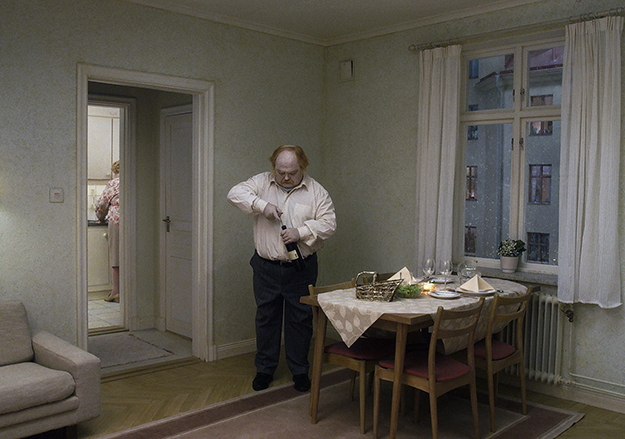
There’s arguably more of a narrative thread in this film than in the other two chapters. It involves two glum salesmen, Sam (Nils Westblom) and Jonathan (Holger Andersson), half-heartedly trying to shift a line of joyless amusement items: a set of vampire teeth, a bag that emits hysterical cackling (“a classic”), and a Nosferatu-like fright mask (“Uncle One-Tooth”) that makes you feel you may as well give up laughter altogether as too damn depressing. This duo just want to help people have a good time, they constantly declare—but no one is remotely having one, them least of all. Jonathan in particular is ever more despairing and exhausted, his characteristic utterance a feeble “Ouwww…” sound. At one point, the duo find themselves in a bar which is suddenly invaded by the army of Sweden’s 17th-century King Charles XII, on its way to being soundly defeated by the Russians. This single-take scene is a brilliant feat of choreographed anachronism lasting just under 11 minutes, and involving the only camera move (a barely perceptible pan right) that I spotted in the film. Few directors could have tackled something this loopily unexpected (it’s akin to the arrival of the Spanish Inquisition in Monty Python), yet played it so surreally straight, and with such poise. Another unlikely touch: playing in the bar at the start is the rockabilly number “Shimmy Doll” by Ashley Beaumont The 18th—exactly the type of boisterous but slightly sad Fifties obscurity you’d expect to turn up in a Kaurismäki movie but, in fact, it featured in Buñuel’s Viridiana, and Andersson is presumably using it with homage in mind.
Andersson occasionally offers moments of joy or at least respite, although they’re fragile: two lovers canoodle on a (relatively) sunny beach, while their dog looks on; two young girls blow bubbles on a tiny balcony that looks as if it’s about to snap off from the apartment block it’s attached to. And there’s a wonderful flashback, showing a cellar bar as it was in 1943. The seductive owner “Limping Lotte” doles out shot glasses in exchange for kisses; as servicemen line up to pay the price of a drink, she swoons rapturously in their embraces, the entire company meanwhile singing the bar’s theme song, to the tune of “John Brown’s Body.” It’s a wonderful uplifting moment, an oasis of joy and everyday eroticism; it’s only undercut by a return to the bar today and an ancient, deaf customer, who’s presumably remembering or imagining the place’s better days (what’s more, the same tune is later heard as the melody of the Swedish Army’s march to defeat).
We’re all redeemed, then—so it would seem—by our capacity to find joy even in the midst of desperation. Yet that itself is partly what worries Andersson—our hunger for entertainment at all costs. Late in the film we get a horrible insight into what having a “good time” might actually mean. Immediately after the monkey scene comes another nightmare tableau. English-speaking soldiers in pith helmets herd black captives into an enormous brass drum; fire is started, the heated drum revolves, and the screams of those trapped inside are converted, through trumpets, into an eerie parody of heavenly music. A cutaway then reveals this grisly spectacle as an entertainment laid on for an audience of ancient spectators in evening dress. Then Jonathan, who’s been serving the spectators drinks, narrates the dream he’s just had, all the more horrible for his complicity. He’s none too happy about what’s involved in the business of entertainment, and neither, it seems, is Andersson. Perhaps it’s in the very essence of some people having a “good time” that others will have a very bad time: the logic of Roman circuses, or torture porn. As Jonathan weeps over his predicament, Sam wearily explains to the warden of the glum hostel where they live: “He’s being a little philosophical.”
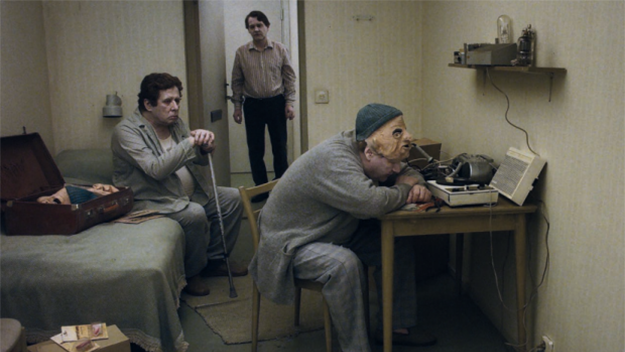
This is perhaps as close as Andersson comes to making an explicit statement—although the more dreamlike and enigmatic his scenarios are, the more effective they are, while some of the more overt depictions of inhumanity, both here and in the other films, are a little too direct to really be philosophically incisive. He does end Pigeon, however, on a sublime note of ambivalence. People stand in the street waiting for their bus. “And then it’s Wednesday again,” announces the proprietor of a nearby bike shop, apropos of nothing. “But it felt like Thursday,” a man responds, his certainties suddenly shattered. Still, it’s a blessing: the man has one extra day to live. It’s also a curse: the man has one extra day to live. How you read Andersson’s take on existence depends on your own predisposition to melancholy—whether your Beckettian glass of Guinness is half-full or half-empty.







